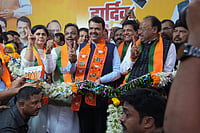The Maratha community remains far from being please over its quota woes even after the Shinde government approved a 10 per cent reservation in jobs and education. But the movement’s resilient protests and hunger strikes have invigorated demands for caste-based reservation from other communities, further increasing a dilemma for the ruling BJP led alliance.
After the Maratha agitation turned violent and a dozen youth committed suicides, the state Assembly in February, ahead of the Lok Sabha polls, passed a Bill to provide Marathas a separate 10 per cent reservation quota. Manoj Jarange-Patil, the leader of the quota agitation, however rejected the grant, as the government failed to meet the original demand to include all Marathas in the OBC category.
This was the third such bill tabled for the Maratha quota in the last ten years. Earlier, the Bombay High Court (2014) and the Supreme Court (2021) struck down the 16 per cent reservation citing no valid grounds to exceed the 50 per cent quota ceiling. The state government must convincingly prove the case of the community’s backwardness to exceed the 50 per cent cap in Maharashtra. Marathas fear the outcome of the latest 10 per cent reservation will eventually meet the same fate.
Marathas are the socially and politically dominant caste group including the higher class 96 Kolis, Kshatriya warriors and agrarian peasants. In Konkan and parts of Western Maharashtra, Marathas are known as Kunbis and fall under the OBC category. In Marathwada region, the epicenter of farmers suicide and prolonged drought, large population of Marathas are socially and economically deprived. The region administered by the Nizam of Hyderabad until 1948, had very few Marathas registered as Kunbis. The core demand put forth by Jarange-Patil was that the state government pass a law on the basis of blood relations so that the kith and kin ‘sage soyare’ of Kunbis can be included under OBC.
The demand has caused a rift in the Maratha-OBC unity and upset the OBC lobby over weakening of their quota. OBC leader Chhagan Bhujbal who is part of the ruling NCP Ajit Pawar faction slammed the government for pandering to Jarange-Patil’s demands. Marathas comprising roughly 30 per cent of the state’s population and the OBC at 52 per cent command a large vote share.
On the other hand, Jarange-Patil’s quota strategy of getting all Marathas reservation under OBC category has inspired the Dhangar community to seek higher reservation with a category change as Dhangads. Dhangars are the second largest caste-based group after the Marathas and constitute around 10 per cent of the state’s population. Traditionally living as nomads and engaged in sheep and cattle grazing, Dhangars are placed under the Nomadic Tribes category, which provides them with 3.5 per cent reservations in government jobs and education.
The Dhangad (cultivators) are listed as a Scheduled Tribe and gets 7 per cent reservation. Dhangar leaders have claimed that Dhangar and Dhangad are same and want to be included under ST category. The Bombay Hight Court in February dismissed petitions of Dhangars seeking Scheduled Tribe status as lacking "any merit.” The demand has distressed Adivasis, as the inclusion of Dhangars in the ST will dilute their quota
Dhangars in Maharashtra are part of BJP’s MADHAV formula: Mali-Dhangar-Vanjari, a caste based political equation to counter Congress’s Maratha-Dalit-Muslim vote bank politics. The Dhangar and Maratha reservation row forced the BJP-Sena-NCP Mahayuti coalition to make serious calculations to retain their support during elections.
To appease the Dhangars, the Shinde government renamed Ahmednagar district as Ahilya nagar after Ahilyabai Holkar, the queen of Holkar dynasty who hails from the community and is revered by many. The coalition also cornered Dhangar leader Mahadev Jankar, founder of Rashtriya Samaj Paksha (RSP), in its camp. Jankar who was keen on joining the NCP Sharad Pawar faction, was given a ticket to contest Lok Sabha elections from Parbhani. CM Shinde has also formed a committee to study if Dhangars can be granted reservation under ST category.
While, the BJP aimed to get Maratha support, the 10 per cent reservation has instead backfired. In Beed Lok Sabha, the party faced black flags and road blocks from the Marathas as it went to campaign for its candidate Pankaja Munde, belonging from the OBC Vanjari community. In Jalna and Osamanabad constituencies too, distress over farm and livelihood crisis has put BJP members to face ire of the villagers. Additionally, Jarange-Patil has announced to take over the BJP in the assembly elections by fielding and getting Maratha candidates elected.
Shinde has assured that his government will deal with future reservation demands from other communities in the same way as it did for the Maratha community. The announcement has stirred the upper caste Brahmin community to demand a survey to assess economic backwardness and seek reservation benefits.
The growing demands for a caste survey and caste based reservations has put the BJP’s position of power in the state and the center in a bind. With the state assembly elections due in the next six months, BJP will not just have to engage in heavy lifting but redraw certain power equations to keep its caste-based vote bank intact.

















